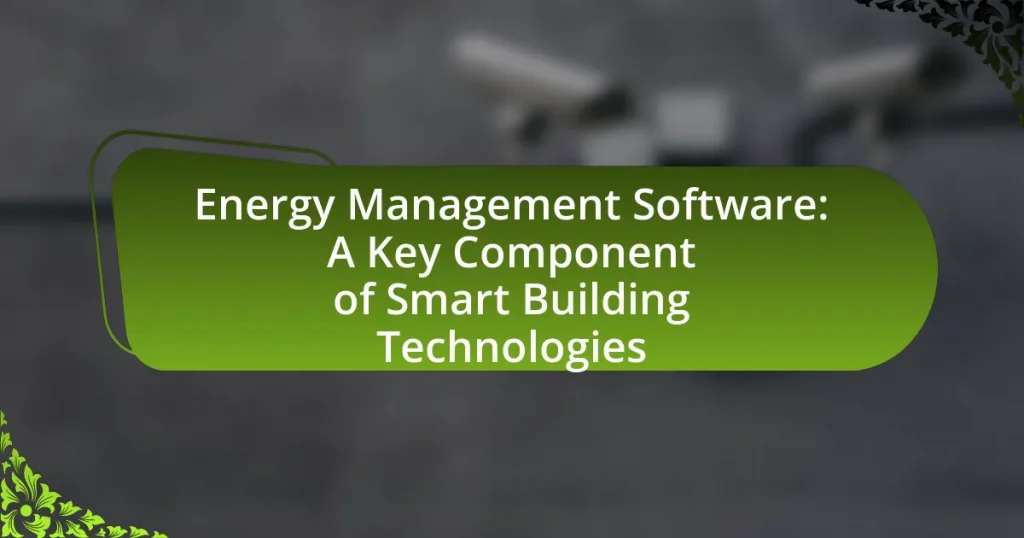Energy management software is essential for organizations striving to achieve net zero goals by enabling the monitoring, analysis, and optimization of energy consumption. This software provides real-time data that helps identify inefficiencies, implement energy-saving strategies, and integrate renewable energy sources, significantly contributing to emissions reduction targets. Key features include real-time monitoring, data analytics, and automated reporting, which enhance sustainability efforts and facilitate compliance with environmental regulations. The article explores the role of energy management software in supporting net zero initiatives, the benefits of its implementation, and the challenges organizations face without it, while also highlighting future trends and best practices for maximizing its impact.

What is the Role of Energy Management Software in Achieving Net Zero Goals?
Energy management software plays a crucial role in achieving net zero goals by enabling organizations to monitor, analyze, and optimize their energy consumption. This software provides real-time data on energy usage, allowing businesses to identify inefficiencies and implement strategies to reduce their carbon footprint. For instance, a study by the International Energy Agency indicates that effective energy management can lead to energy savings of 10-30%, significantly contributing to emissions reduction targets. By integrating renewable energy sources and automating energy management processes, this software supports organizations in transitioning to sustainable energy practices, ultimately facilitating their journey towards net zero emissions.
How does Energy Management Software contribute to sustainability efforts?
Energy Management Software significantly contributes to sustainability efforts by optimizing energy consumption and reducing waste. By providing real-time data analytics, this software enables organizations to identify inefficiencies in energy use, leading to targeted interventions that lower energy demand. For instance, a study by the U.S. Department of Energy found that implementing energy management systems can reduce energy consumption by 10-30%, directly impacting carbon emissions. Additionally, the software facilitates the integration of renewable energy sources, further enhancing sustainability by decreasing reliance on fossil fuels.
What features of Energy Management Software support net zero initiatives?
Energy Management Software supports net zero initiatives through features such as real-time energy monitoring, data analytics, and automated reporting. Real-time energy monitoring allows organizations to track energy consumption patterns, enabling them to identify inefficiencies and reduce waste. Data analytics provides insights into energy usage trends, helping organizations make informed decisions to optimize energy efficiency. Automated reporting simplifies compliance with sustainability regulations and benchmarks progress towards net zero goals. These features collectively empower organizations to implement strategies that significantly lower carbon emissions and enhance overall energy performance.
How does data analytics enhance the effectiveness of Energy Management Software?
Data analytics enhances the effectiveness of Energy Management Software by providing actionable insights through the analysis of energy consumption patterns. By leveraging data analytics, organizations can identify inefficiencies, optimize energy usage, and forecast future energy needs, leading to reduced costs and improved sustainability. For instance, a study by the U.S. Department of Energy found that implementing data analytics in energy management can lead to energy savings of 10-30%. This quantifiable impact demonstrates how data-driven decisions can significantly contribute to achieving net zero goals.
Why is Energy Management Software essential for organizations aiming for net zero?
Energy Management Software is essential for organizations aiming for net zero because it enables precise monitoring, analysis, and optimization of energy consumption. By providing real-time data on energy usage, organizations can identify inefficiencies and implement strategies to reduce their carbon footprint. For instance, a study by the International Energy Agency found that effective energy management can lead to energy savings of 10-30%, significantly contributing to net zero targets. Furthermore, this software facilitates compliance with regulations and reporting requirements, ensuring that organizations can track their progress towards sustainability goals accurately.
What challenges do organizations face in achieving net zero without Energy Management Software?
Organizations face significant challenges in achieving net zero without Energy Management Software, primarily due to the lack of data-driven insights and real-time monitoring capabilities. Without this software, organizations struggle to accurately track energy consumption, leading to inefficient resource allocation and missed opportunities for optimization. Additionally, the absence of automated reporting hinders compliance with regulatory requirements and sustainability goals, as organizations cannot easily demonstrate their progress. Furthermore, without Energy Management Software, organizations may find it difficult to identify and implement energy-saving measures, resulting in higher operational costs and increased carbon emissions. These challenges collectively impede the ability to develop effective strategies for reducing greenhouse gas emissions and achieving net zero targets.
How does Energy Management Software facilitate compliance with environmental regulations?
Energy Management Software facilitates compliance with environmental regulations by providing real-time monitoring and reporting of energy consumption and emissions data. This software enables organizations to track their energy usage against regulatory standards, ensuring that they meet legal requirements. For instance, by automating data collection and analysis, Energy Management Software helps businesses identify areas of inefficiency and implement corrective measures, thereby reducing their carbon footprint. Additionally, many Energy Management Software solutions include features that generate compliance reports, simplifying the process of demonstrating adherence to environmental regulations. This capability is crucial for organizations aiming to achieve net-zero goals, as it aligns operational practices with sustainability mandates.
What are the key benefits of implementing Energy Management Software?
Implementing Energy Management Software provides significant benefits, including enhanced energy efficiency, cost savings, and improved sustainability. Energy Management Software enables organizations to monitor and analyze energy consumption in real-time, leading to optimized energy use and reduced waste. According to a study by the U.S. Department of Energy, companies that implement energy management practices can achieve energy savings of 10% to 30%. Additionally, this software supports compliance with regulatory requirements and helps organizations track their progress toward net zero goals, ultimately contributing to a reduction in greenhouse gas emissions.
How does Energy Management Software improve energy efficiency?
Energy Management Software improves energy efficiency by providing real-time monitoring and analytics of energy consumption. This software enables organizations to identify inefficiencies, optimize energy usage, and implement strategies for reduction. For instance, a study by the U.S. Department of Energy found that organizations using energy management systems can achieve energy savings of 10% to 30%. By analyzing data trends, the software helps in making informed decisions that lead to reduced energy waste and lower operational costs.
What cost savings can organizations expect from using Energy Management Software?
Organizations can expect significant cost savings from using Energy Management Software, typically ranging from 10% to 30% on energy expenses. This software enables real-time monitoring and analysis of energy consumption, allowing organizations to identify inefficiencies and implement targeted energy-saving measures. For instance, a study by the U.S. Department of Energy found that companies using energy management systems achieved an average energy cost reduction of 15%, translating to substantial financial savings over time. Additionally, organizations can benefit from reduced operational costs through improved energy efficiency, which can lead to lower utility bills and decreased maintenance expenses.
How can organizations effectively integrate Energy Management Software into their operations?
Organizations can effectively integrate Energy Management Software (EMS) into their operations by first conducting a comprehensive energy audit to identify consumption patterns and inefficiencies. This initial assessment allows organizations to tailor the EMS to their specific needs, ensuring that it addresses the most critical areas for improvement.
Next, organizations should ensure that the EMS is compatible with existing systems and infrastructure, facilitating seamless data integration and communication across departments. Training staff on the software’s functionalities is essential, as it empowers employees to utilize the tool effectively, leading to better energy management practices.
Furthermore, organizations should establish clear goals and metrics for energy performance, enabling them to track progress and make data-driven decisions. Regularly reviewing and updating the EMS based on performance data and evolving organizational needs will enhance its effectiveness over time.
Research indicates that organizations that implement EMS can achieve energy savings of 10-30%, significantly contributing to their net zero goals by reducing overall energy consumption and greenhouse gas emissions.
What are the best practices for utilizing Energy Management Software to achieve net zero goals?
The best practices for utilizing Energy Management Software (EMS) to achieve net zero goals include continuous monitoring of energy consumption, setting clear energy reduction targets, and integrating renewable energy sources. Continuous monitoring allows organizations to identify inefficiencies and track progress in real-time, which is essential for making informed decisions. Setting clear energy reduction targets provides a measurable framework for achieving net zero goals, ensuring that all stakeholders are aligned and accountable. Integrating renewable energy sources into the EMS enhances sustainability efforts by reducing reliance on fossil fuels, thus contributing to overall emissions reduction. According to the International Energy Agency, implementing EMS can lead to energy savings of 10-30%, significantly aiding in the transition to net zero.
How can organizations measure the success of their Energy Management Software implementation?
Organizations can measure the success of their Energy Management Software (EMS) implementation by evaluating key performance indicators (KPIs) such as energy consumption reduction, cost savings, and improved operational efficiency. For instance, a study by the U.S. Department of Energy indicates that organizations can achieve energy savings of 10-30% through effective EMS, demonstrating tangible benefits. Additionally, tracking metrics like carbon footprint reduction and compliance with sustainability goals provides further evidence of success. Regular audits and benchmarking against industry standards also help organizations assess the effectiveness of their EMS in contributing to net zero goals.
What common pitfalls should organizations avoid when adopting Energy Management Software?
Organizations should avoid inadequate stakeholder engagement when adopting Energy Management Software. Failing to involve key stakeholders can lead to misalignment of goals and underutilization of the software. Additionally, neglecting proper training for users can result in ineffective use of the system, ultimately hindering energy management efforts. Research indicates that organizations that prioritize user training and stakeholder involvement see a 30% increase in software effectiveness, demonstrating the importance of these factors in successful implementation.
What future trends in Energy Management Software could impact net zero goals?
Future trends in Energy Management Software (EMS) that could impact net zero goals include the integration of artificial intelligence (AI) for predictive analytics, enhanced data interoperability, and the adoption of blockchain technology for energy transactions. AI-driven EMS can analyze vast datasets to optimize energy consumption and predict future energy needs, leading to more efficient resource allocation and reduced emissions. Enhanced data interoperability allows for seamless communication between various energy systems, facilitating real-time monitoring and management, which is crucial for achieving net zero targets. Additionally, blockchain technology can provide transparent and secure energy transactions, promoting decentralized energy production and consumption, which supports the transition to renewable energy sources. These trends collectively contribute to more effective energy management strategies that align with net zero objectives.
How is artificial intelligence shaping the future of Energy Management Software?
Artificial intelligence is significantly shaping the future of Energy Management Software by enhancing predictive analytics, optimizing energy consumption, and enabling real-time decision-making. AI algorithms analyze vast amounts of data from various sources, allowing for accurate forecasting of energy demand and supply, which leads to more efficient energy usage. For instance, a study by the International Energy Agency in 2021 highlighted that AI-driven systems could reduce energy consumption by up to 10% in commercial buildings. Additionally, AI facilitates automated adjustments in energy systems, improving operational efficiency and supporting the transition to renewable energy sources. This integration of AI not only aids in achieving net-zero goals but also promotes sustainability by minimizing waste and maximizing resource utilization.
What role does IoT play in enhancing Energy Management Software capabilities?
IoT significantly enhances Energy Management Software capabilities by providing real-time data collection and analysis. This integration allows for improved monitoring of energy consumption patterns, enabling organizations to make data-driven decisions that optimize energy usage. For instance, IoT devices can track energy usage at granular levels, facilitating predictive analytics that identify inefficiencies and suggest corrective actions. According to a report by the International Energy Agency, implementing IoT in energy management can lead to energy savings of up to 30%. This quantifiable impact underscores the effectiveness of IoT in driving energy efficiency and supporting net zero goals.
What practical steps can organizations take to maximize the impact of Energy Management Software on net zero goals?
Organizations can maximize the impact of Energy Management Software (EMS) on net zero goals by implementing real-time energy monitoring, optimizing energy usage through data analytics, and integrating renewable energy sources. Real-time monitoring allows organizations to track energy consumption patterns, identify inefficiencies, and make informed decisions to reduce waste. Data analytics can reveal trends and provide actionable insights, enabling organizations to optimize their energy usage and reduce carbon emissions effectively. Furthermore, integrating renewable energy sources, such as solar or wind, into the EMS can help organizations transition to cleaner energy, directly supporting their net zero objectives. According to the International Energy Agency, effective energy management can lead to a reduction of up to 30% in energy consumption, significantly contributing to net zero targets.



